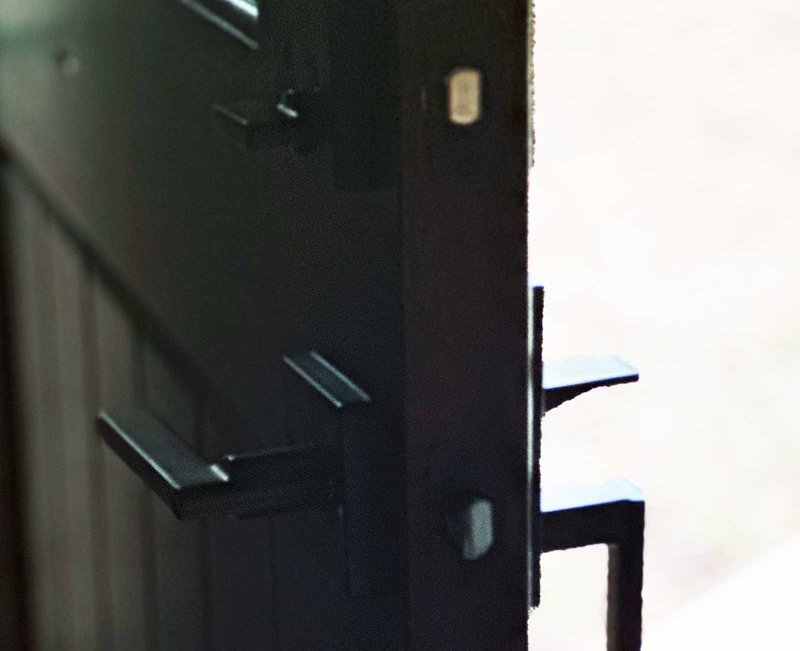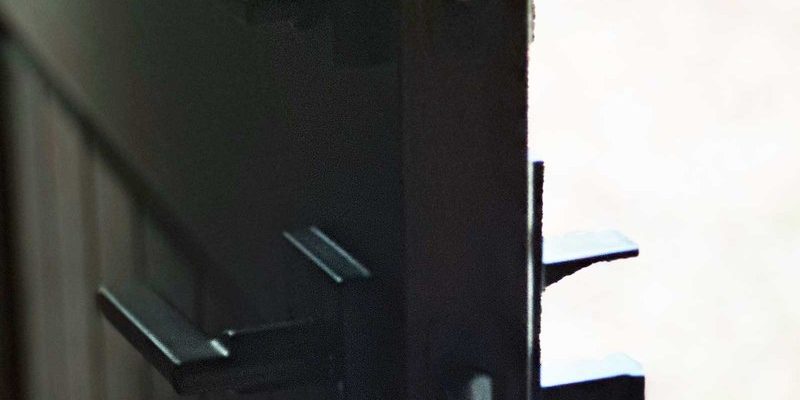
So, what’s actually going on here? Is your door just getting old, or is there something deeper at play? Even if your lock is a high-end Schlage, Kwikset, Yale, or any other brand, excessive clicking from an exterior door latch almost always points to some kind of mechanical hiccup—sometimes a maintenance issue, sometimes a sign you’ll need to break out the toolbox (or call the pros). Let’s dig in together and make sense of what’s happening behind those frustrating clicks.
What’s Normal for an Exterior Door Latch?
Let’s start with what’s supposed to happen: When you press down on the handle or knob, the latch pulls back (retracts), and you can open the door. When you release it, a spring pushes the latch back out into the strike plate, holding the door shut. Normally, you’ll hear a soft “click” as the latch pops into place, but it’s usually subtle.
So, what counts as “excessive” here? If you hear several clicks in a row, a loud snap, or noises every time you nudge the door, that’s a clue something’s off. Honestly, you shouldn’t be hearing a soundtrack of clicks as you walk by or as the wind moves your door even a little.
Here’s the thing: modern door latches are designed for hundreds of open/close cycles every week, so they’re pretty sturdy. But over time, even the best brands—Schlage, Kwikset, Yale, you name it—can start making noise if something in the mechanism goes awry. And if you’ve just installed a new smart lock, keypad system, or pairable remote lock, the problem might not be mechanical at all but instead related to code sync or battery issues causing the latch to act weird. Whatever the cause, an exterior door latch that clicks excessively definitely needs some attention.
Common Causes of Excessive Door Latch Clicking
Most excessive clicking comes down to friction, misalignment, or a failing component. Let me explain:
- Misaligned Strike Plate: If the strike plate (the metal piece on the door frame where the latch pops in) isn’t lined up just right, your latch might hit the edge or slide past it, causing repetitive clicks as it tries to seat itself.
- Dirt and Debris: Grit, dust, or even remnants of old lubricant can build up inside the latch or on the strike plate, making the parts rub or stick. That friction leads to extra noise every time you move the latch.
- Worn-Out Spring: The spring inside the latch pushes the bolt in and out. If it’s rusted or stretched out, it can cause inconsistent clicks or a sluggish feel.
- Loose or Damaged Hardware: Screws in the lock or knob can loosen over time—especially on doors that get slammed. This creates wiggle room and extra noise.
- Smart Lock Glitches: If you’ve got an electronic lock or remote-operated deadbolt, battery issues or code sync problems can make the latch “cycle” repeatedly, creating clicking noises as the lock tries to reset or pair.
Pro tip: Excessive door latch clicking is almost never “normal.” Even if your door still locks, it’s a sign you need to check things out before the problem gets worse.
How to Diagnose the Source of Clicking
Before you grab tools or call a locksmith, it’s smart to pinpoint where the sound is coming from. This isn’t just about saving yourself a headache—it makes the fix way easier. Here’s how you can figure it out:
- Open and Close the Door Slowly: Move the handle and listen closely. Is the clicking only when you push the handle down, or does it happen as the door latches shut?
- Test With the Door Open: Try operating the latch when the door’s open. If you still hear the clicking, it’s likely inside the knob/lock. If not, it’s probably a strike plate alignment issue.
- Check for Play in the Handle or Knob: Wiggle the handle gently. If there’s a lot of movement or a rattling sound, loose parts might be the culprit.
- Inspect for Visible Dirt/Buildup: Take a flashlight and look inside the latch opening and around the strike plate. You’d be surprised how much gunk can collect here, especially on exterior doors exposed to the elements.
- For Electronic or Remote Locks: If you’ve got a smart system that syncs or pairs with a remote, try re-syncing the code and check the battery. Low battery or a failed sync cycle can cause the lock to engage and disengage repeatedly, making clicking noises.
It might feel a bit like being a detective, but trust me, a few minutes spent narrowing down the noise will save you from trial-and-error repairs.
Fixing Misalignment: Strike Plate and Door Position
Strike plate misalignment is the most common reason for repeated clicking. Here’s the thing: even a small shift in your door’s position—maybe from swelling, humidity, or house settling—can throw everything off. When the latch can’t pop squarely into its pocket, it clicks and clatters as it tries to catch.
Here’s how to fix it:
- Check the Strike Plate: Look for wear or shiny spots where the latch hits off-center. That’s your clue it’s rubbing.
- Adjust the Strike Plate: Usually, you can loosen the screws and nudge the plate a fraction up, down, or sideways to line things up. If the misalignment is big, you might need to file the hole a bit wider.
- Tighten All Screws: Give both the strike plate and all the lock/knob screws a turn. Sometimes, a little tightening is all it takes.
- Test the Door Movement: After any adjustment, close the door slowly and listen. The click should be just one—and nice and soft.
Insight: Sometimes the fix is as simple as tightening a loose screw. If the problem only happens in certain seasons (like when it’s humid), you might need to check once a year.
Cleaning and Lubricating Your Door Latch
Honestly, exterior door latches live a tough life. Rain, dust, and temperature swings all work together to gum up the works. If your latch is clicking, cleaning and lubrication can sometimes restore it to near-silent operation.
How to clean and lubricate your latch:
- Gather Supplies: You’ll need a can of spray lubricant (like WD-40 or a silicone spray), a rag, and maybe a small brush or cotton swabs.
- Clean the Latch and Strike Plate: Wipe away visible dirt. If you see buildup inside the latch opening, use a brush or swab to gently clear it out.
- Apply Lubricant: Spray directly into the latch mechanism, then operate the handle a few times to work it in. Wipe away any excess.
- Don’t Overdo It: A little goes a long way. Too much lubricant attracts more dust, which can actually cause problems down the line.
You’d be amazed how much difference a two-minute cleaning can make. If the click is gone, you’ve likely solved a dirt or friction problem. If not, the issue might be inside the lock.
When to Replace the Latch or Lockset
Sometimes repair just isn’t enough. A latch that clicks excessively despite cleaning and tightening probably has an internal part that’s worn or broken. Springs can lose tension. Plastic parts (especially on cheaper or older locks) can crack. And no amount of DIY will make a failing mechanism whisper-quiet again.
Here’s when it’s time to swap in a new lock:
- You Still Hear Clicking After All Fixes: If you’ve cleaned, aligned, and tightened everything, and the noise keeps coming back, replacement is the smart move.
- Latch Feels Sloppy or Stiff: A handle that sags or a latch that doesn’t pop in and out smoothly is a red flag for internal wear.
- Visible Damage: If you see cracks, corrosion, or missing parts, don’t wait—replace it now, especially on exterior doors where security matters.
- Upgrading to a Smart Lock: If your lock is old and was giving trouble anyway, upgrading to a reliable brand (Yale, Schlage, etc.) with features like remote code syncing and low-battery alerts can save you headaches down the road.
Note: If you’re not sure how to install a new lock, most hardware stores offer quick tutorials. Or you can find step-by-step “how-to” videos online.
Troubleshooting Clicking on Smart and Remote Locks
If your exterior door latch uses a smart or remote lock, the solution might not be mechanical at all. These devices add convenience—keypads, pairing with your phone, code resetting, the whole shebang—but they do bring their own quirks.
Here’s what to check with smart locks:
- Battery Power: Clicking or cycling noises can come from low batteries. If your lock buzzes, clicks, or keeps trying to engage, swap in fresh batteries.
- Code or Sync Errors: Sometimes, if the remote or keypad isn’t paired properly, the lock’s motor keeps trying (and failing) to extend or retract the latch. Reset the code or perform a sync/pair procedure as described in your manual.
- App/Software Updates: Occasionally, a glitchy update or app bug can cause the motor to misbehave. Check for firmware updates or reinstall the app if you use one.
If after resetting, pairing, and swapping batteries your smart lock still clicks like crazy, it might be a sign of a hardware failure. At that point, check your warranty and think about a replacement.
Preventing Future Latch Problems
The best way to keep your exterior door latch operating quietly is with a little regular care. Most of us ignore our locks until they get noisy, but honestly, a minute or two every few months can dodge a lot of drama.
- Keep It Clean: Wipe down the latch and strike plate every so often, especially if you live in a dusty or humid place.
- Lubricate Lightly: Every six months, give the latch a quick spray with silicone or graphite lubricant. Avoid oil-based products on smart or electronic locks.
- Check for Alignment: If you feel extra resistance or need to “force” the door, check and adjust the strike plate before problems start.
- Smart Locks Need Attention, Too: Replace batteries as soon as you see a warning. Re-sync your code or re-pair the remote if things start acting up.
These steps aren’t flashy, but they keep things smooth and quiet—just like a good latch should be.
When to Call a Locksmith or Pro
Here’s the thing: most latch problems are a quick fix, but now and then you’ll hit a wall. Maybe the entire lock turns loosely in your hand, or you can’t figure out what’s making all the racket, or your door still won’t close right after you’ve tried every trick in the book.
Don’t beat yourself up—it happens to everyone. Locksmiths are pros for a reason. If your lock is high-security, electronic, or handles your main entry, letting a professional take a look can save you both money and stress in the long run.
A good locksmith can:
- Diagnose tricky alignment issues that you might miss
- Replace or repair parts inside the lock that aren’t accessible without special tools
- Re-key or re-sync smart locks if you can’t get them working
- Offer advice on upgrades for extra security
Tip: Before calling, snap a photo or video of the issue. It helps the locksmith prepare and can sometimes mean a cheaper, faster fix.
Wrapping Up: Keeping Your Door Quiet and Secure
An exterior door latch that clicks excessively is your home’s way of waving a little red flag. Sometimes it’s a quick fix—a screw here, a dab of lubricant there. Other times, it tells you the lock is nearing the end of its life, or an electronic glitch is making your smart lock throw a tantrum.
Either way, it pays to listen. Catch the noise early, run through these checks, and you’ll keep your entryway trouble-free and your mind at ease. And remember—whether your door uses a classic Kwikset latch or the latest remote-synced smart lock, a little attention goes a long way toward keeping those clicks at bay.
